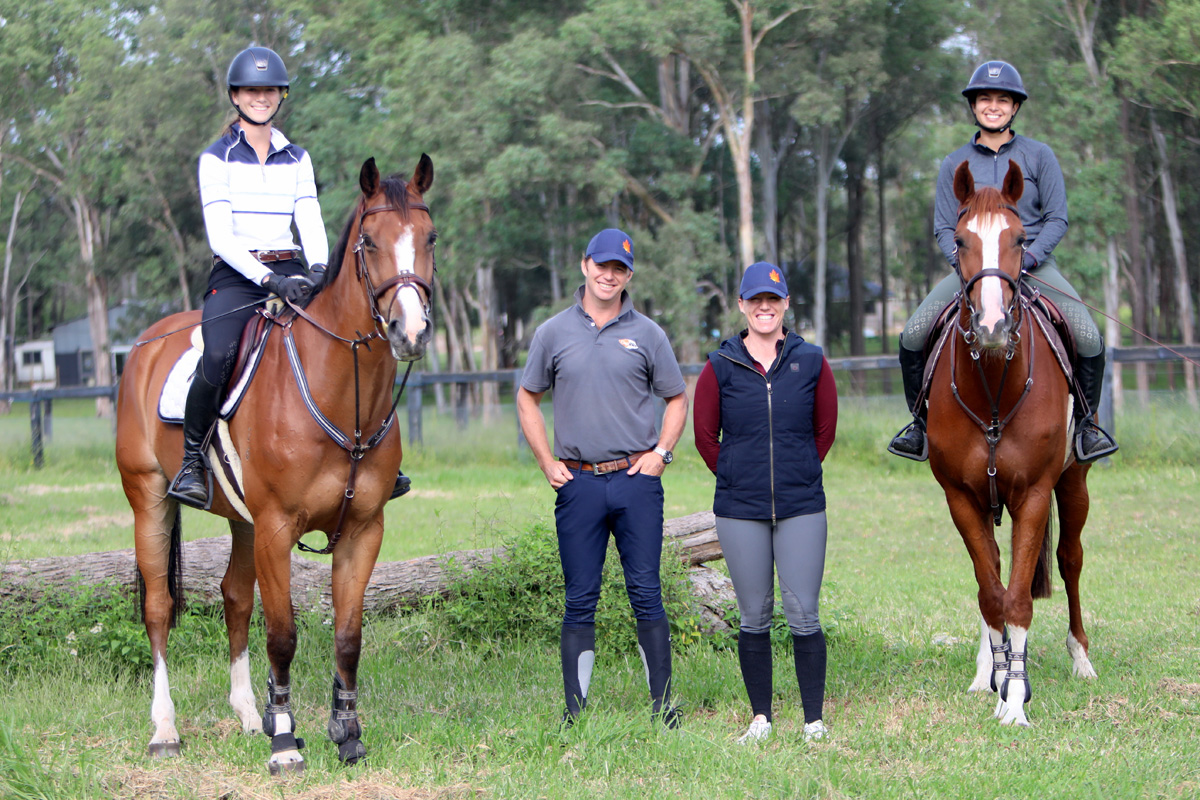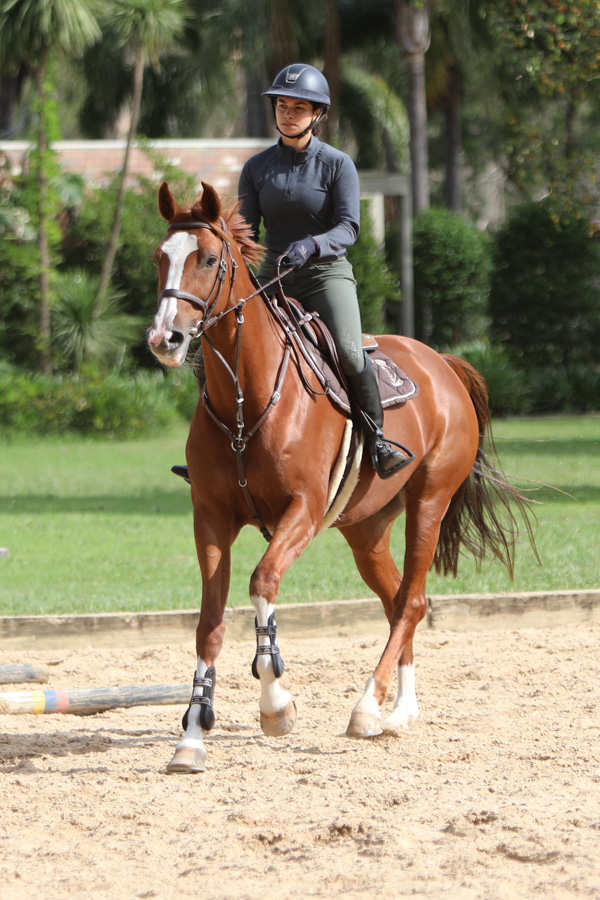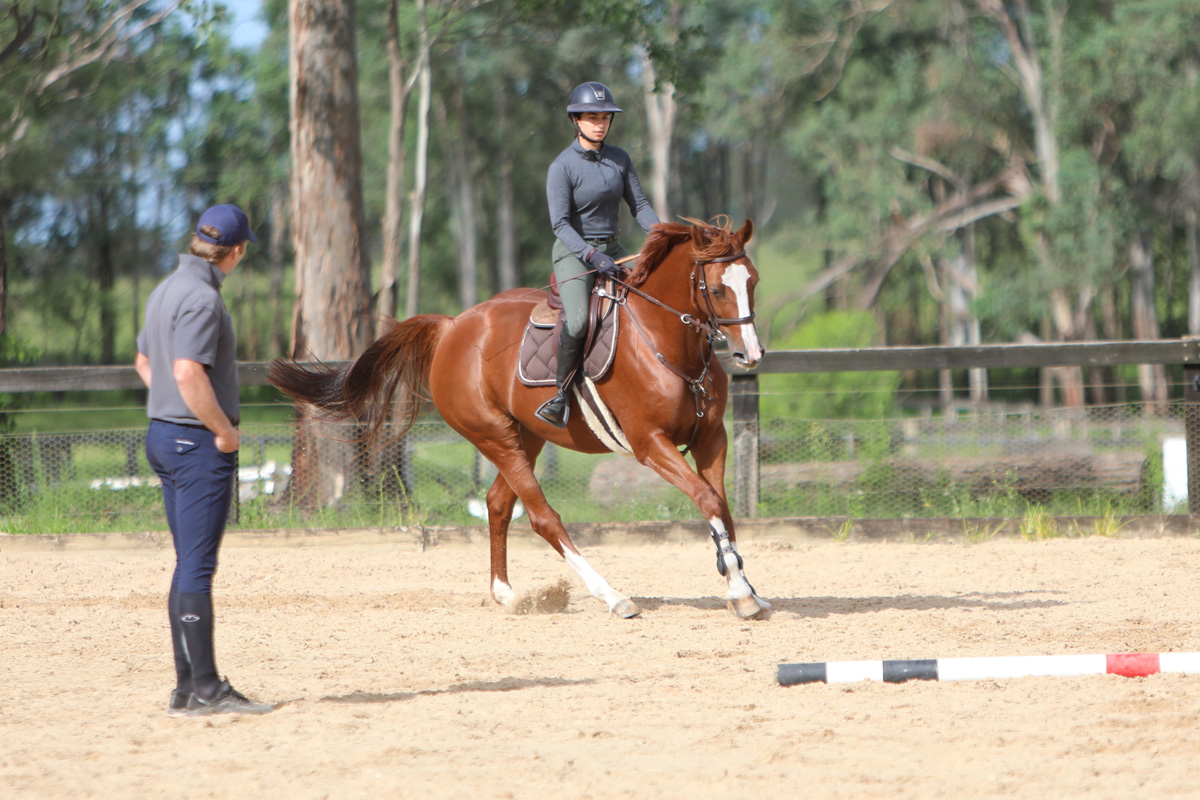Who better to share their insights into flatwork training for jumpers than Dave and Tallara Cameron? The couple were both jointly named EA NSW 2020 Coach of the Year for jumping.
Dave and Tallara Cameron are one formidable pair, whether it be competing at World Cup showjumping level or helping their many students at the warm-up fences at competitions. They are equally comfortable in all aspects of the sport at home at Wilberforce, NSW, training and schooling young horses or passionately coaching showjumping students on their Redleaf Lodge arena.
Dave is now on the Equestrian Australia board and is putting back into equestrian sports with the same passion that engulfs his love of horses showjumping and seeing a way for Australians to have better pathways to international exposure and competition. Tallara is cool, calm and collected with a compassionate way about her that is endearing to all she coaches and befriends.
These two are certainly on a roll — and that’s from good management, not good luck. Through hard work and good decisions, passion, above all, steers their ways.
So well do they work as a team that they were both nominated separately at the 2020 NSW EA awards, in a very strong field of nominees, for Coach of the Year. It was seen fit that they both be given the title together and that’s attributable to how well they work as a team. What a huge honour and accolade to them both, and it’s just how they roll. Humble, gracious and talented.

They both pay great attention to good, basic flatwork. With Tallara’s background in eventing, she really appreciates the necessity of having showjumpers on the aids and responsive. This is so the adjustability between fences and down tricky lines always remains with the rider.
Jumping exercises are also of the utmost importance, but without a horse that is adjustable forward and back, and flexible and confidently balanced left and right, the jumping exercises are of little use.
Flatwork and control of the showjumper is, of course, important, but unlike the control of a dressage horse that must pay total attention at every moment to the rider and be totally aware of his every signal, a showjumper has the most important job to jump the fence and focus on the rails to be jumped. He has to have his own initiative; this is where the training for dressage competition, and the training for control between fences, varies a little between the two disciplines.
If the rider is too dominant in the horse’s mind then that will interfere with his concentration to jump the fence. So it’s important to have a smooth, confident connection and help the horse between the fences — not to over-dominate and be a serious distraction when it is time in the last few strides to the fence to be somewhat insignificant, but to be simply balanced and encouraging.

“The horses learn to trust
and believe in the rider’s
easy aids.”
BALANCE & RHYTHM
The Camerons have a very simple rule that follows throughout our entire training regime from the 50cm babies to the Grand Prix horses. Balance and rhythm is their basic creed:
This is of the utmost importance. We start with our horses in big areas, usually in the cross country arena where there is a lot of room. We know there are no ribbons for the horse with the prettiest, rounded outline in jumping — there are only ribbons for clear rounds.
Every horse needs to find a rhythm and a balance that suits their individual conformation to allow them to carry the rider in a confident way and jump a fence in the way they naturally want to. Contact is, for sure, an important aspect, but it’s about a contact that is consistent with a frame that enhances their balance and rhythm, and allows confident adjustability.

Every horse is different, with differing attitudes to contact and neck length. We well understand the deep and round theory and the effect on the dressage horse’s ability to look and perform well. Jumpers, however, really need a longer neck and to learn to stay longer out into a steady, confident contact — but still on the hind leg.
When they jump, they don’t need to exaggeratedly go from a short, restricted neck to a long, open neck over the fence. This huge variation of neck length is 1) unbalancing and 2) hard for the rider to accommodate. We prefer balance, rhythm and a steady, more open frame and consistent non-folding frames.
We always simply ride our horses on very definite lines and steady contact until they can trot and canter in balance and in one simple, consistent rhythm. This is done in the beginning in a three-point position. We always have poles strategically placed on the arenas that, once this balance and rhythm is established, we then use poles a lot to encourage focus from the horse and for the rider gain a feeling of adjustability without pressure. From the beginning we insist that for every pole cantered or trotted over, the horse moves dead in the middle of the pole no matter what!
This teaches the horse always to be straight and centred and for the rider to make sure this is a priority – and it then is simply instinctive!


Once the balance, steady frame and contact are established, we start to teach the horse to go forward from the leg pressure of the rider. It’s important to say at this time that to go forward is from the leg of the rider, not from throwing the rein at the horse’s head and losing the contact and hence the balance. To come back is from the upper body coming back and the steady contact encouraging a slower speed but a similar rhythm.
We use rails at distances to show the ability to take six, five or four strides between the rails. We always start with curving lines and not straight lines, as it’s easier for adjustability on this line. Once we have curving, adjustable lines with a confident contact and an effective half-halt, then we incorporate straight lines to curving lines in an adjustable way.

Start simply with six strides to five and back to six. Keep it simple and uncomplicated and not confronting or aggressive. The horses learn to trust and believe in the rider’s easy aids. If the horse becomes unsettled, we simply go back in an open area and re-establish rhythm and balance in a confident contact and outline that suits that horse’s natural balance, and then start back with poles and adjustability. It is repetitive and takes patience and confidence for the horse to believe the rider and trust himself.
We also do a lot of counter canter as we believe this instills more confidence, less panic and better organisation. We start with long, open lines and loops and then whole circles, always making the counter canter balanced and adjustable back and forward. Showjumpers need to learn to balance whether in true or counter canter, and we use a lot of counter canter for balance and confidence.
Once we have our horses to a contact, and balanced and in a good rhythm back and forward, we use shoulder-fore on the circle to encourage an active carrying hind leg — and then from this to travers to train adjustability and an active hind leg. We do this in trot and in canter.
Flatwork for our showjumpers is about the same principles as dressage, but with more inference on a natural balance and rhythm that pertains to each individual horse’s natural ability and balance.
We always need a half-halt. We need more power from behind and more engagement, but it is not so important to have the dressage arched neck and total control of every step and stature.
We say again, it’s all about balance and rhythm.
We love to see our horses steady and in the frame that suits them to produce a better balance. With some it’s up, some down, some in, some out!
We love the dressage attitude but it must always be realised that jumpers need to simply trust their own balance that comes to them as a progression from their conformation. We can only help with steady contact and confident transitions without taking away their own volition and initiative to jump the fence.
Our total aim is to help and not hinder! This takes time, patience, thoughtfulness and, above all, passion and consideration. Enjoy the journey and listen to your horse.

Pull out section:
BALANCE IN ALL ASPECTS
David and Tallara are expert showjumping trainers, however they know that before you start training you need a happy and health horse to begin with!
“Of course, you will never get the most from a horse unless it is fed properly! A wise horseman once said to us, ‘First you must teach the horse to eat, then relax and then to breath. Once you have those three things in place, everything else will come.’ Balance in all aspects is so important; we believe a happy horse starts in the gut with a balanced diet. We feed CopRice and a ryegrass mix hay and see it as the best starting point for our competition horses.”
The pair have been sponsored by CopRice for almost a decade. “We have always found CopRice to have a real team feel and we have enjoyed being a part of that. The reps are knowledgeable and approachable; they are passionate about CopRice feeds and their passion is in infectious, as it comes from a place of genuine respect for the product,” says Tallara.
The couple use CopRice’s Versatile, Cool Conditioner and Performer feeds for their horses depending on their workload. “What we like most about CopRice products is how good they make our horses look, alongside knowing all their nutritional needs are being met. Another plus is how simple feeding CopRice can be!” says Tallara.

